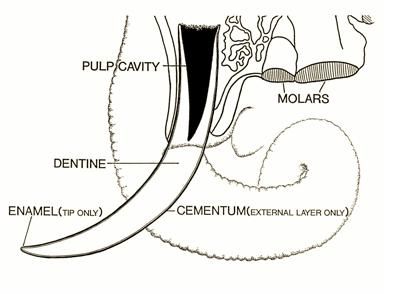
Figure1: Tusk Morphology (from XXX)
Ivory
Figure1: Tusk Morphology (from XXX) |
Ivory is defined as the dentine in any large tusk and may derive from several species (elephant, mammoth, whale, hippopotamus, walrus etc). Ivory tusks consist of a peripheral component, the cementum, continuous with but structurally different from enamel, and a main core of dentine (figure 1). All three components consist of the same materials, hydroxylapatite (Ca-P mineral), organic material (collagen) and water but in varying percentages. The apatite forms dentinal tubules that are embedded in a granular matrix (collagen) and the 3D arrangement of the dentinal tubules and their superimposed structures (e.g. microlaminae) are characteristic for each type of ivory. Primarily CT is applied to ivory as a non-destructive technique of origin determination by analysis of its internal structures. Secondary it is employed for archaeological questions by the analysis of e.g. degree of object preservation, treatment traces etc. |
Click on the links below to see some examples: